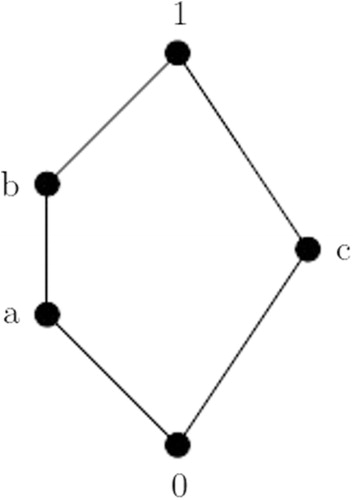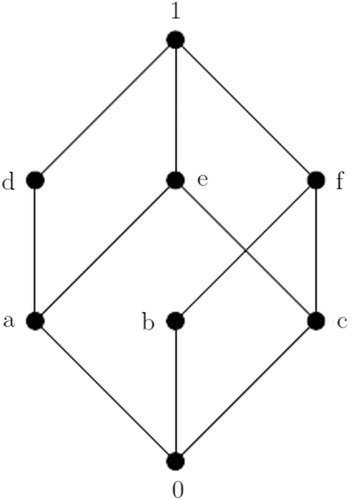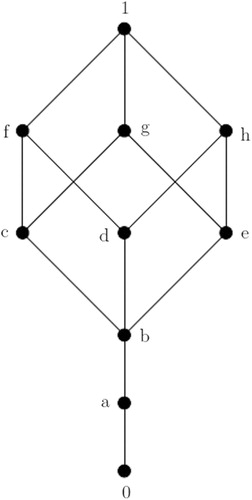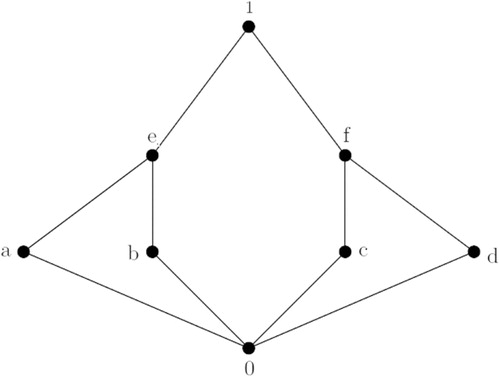 ?Mathematical formulae have been encoded as MathML and are displayed in this HTML version using MathJax in order to improve their display. Uncheck the box to turn MathJax off. This feature requires Javascript. Click on a formula to zoom.
?Mathematical formulae have been encoded as MathML and are displayed in this HTML version using MathJax in order to improve their display. Uncheck the box to turn MathJax off. This feature requires Javascript. Click on a formula to zoom.Abstract
Some generalizations of the concept of a supplemented lattice, namely a soc-supplemented-lattice, soc-amply-supplemented-lattice, soc-weak-supplemented-lattice, soc--supplemented-lattice and completely soc-
-supplemented-lattice are introduced. Various results are proved to show the relationship between these lattices. We have also proved that, if
is a soc-
-supplemented-lattice satisfying the summand intersection property (SIP), then
is a completely soc-
-supplemented-lattice.
1 Introduction
Mutlu [Citation1], Tohidi [Citation2], Wang and Ding [Citation3], Wisbauer [Citation4] and many others have studied the concept of a supplemented module and its generalizations. Let and
be submodules of a module
.
is called a
of
if
and
is minimal with respect to this property. A module
is called an
if for any two submodules
and
of
with
,
contains a supplement of
. A module
is called
if each submodule of
has a supplement that is a direct summand of
.
In 2012, Tohidi [Citation2] introduced some generalizations of the concept of a supplemented module namely, a soc-supplemented-module, a soc-amply-supplemented-module, a soc-weak-supplemented-module, a soc--supplemented-module and a completely soc-
-supplemented-module. He proved various results to show relationship between these modules. He showed that, a direct summand of a soc-amply-supplemented-module is also a soc-amply-supplemented-module.
Călugăreanu [Citation5] used lattice theory in module theory and studied several concepts from module theory in lattice theory. He introduced the concept of a supplement in terms of elements. Alizade and Toksoy [Citation6] introduced the concepts of an ample supplement and an amply supplemented lattice in the context of a complete modular lattice. In [Citation7] they also introduced the concepts of a weak supplement, a weakly supplemented lattice in the context of a complete modular lattice.
In this paper, we introduce the concepts of a soc-supplemented-lattice, a soc-amply-supplemented-lattice, a soc-weak-supplemented-lattice, a soc--supplemented-lattice and a completely soc-
-supplemented-lattice and obtain some results in the context of modular lattices.
Throughout in this paper denotes a lattice. Wherever necessary we assume that
exists for any
and
.
2 Preliminaries
We recall some terms from lattice theory. These and undefined terms can be found in Grätzer [Citation8].
Definition 1
A lattice is called modular if for
with
,
.
Definition 2
If are such that
and
then we say that
are direct summands of
and we write
. We say that
is a direct sum of
and
.
Definition 3
Let be a lattice with 0. An element
is called an atom, if there does not exist any
such that
.
Definition 4
A lattice with 0 is said to be an atomistic lattice if every non-zero element
is the join of atoms of
contained in
.
Definition 5
[Citation5, p. 47]
The join of all atoms of , denoted by
, is called the socle of the lattice
.
For ,
is the socle of the lattice
.
We recall some definitions from Alizade and Toksoy [Citation6,Citation7] and from Călugăreanu [Citation5].
Definition 6
An element is said to be small in
if
for every
. We then write
.
Definition 7
An element is called a supplement of an element
if
and
is minimal with respect to this property.
Lemma 1
Let be a modular lattice and
.
is a supplement of
in
if and only if
and
is small in
.
Proof
Suppose that is a supplement of
in
. Then
and
is minimal with respect to this property. Let
for some
. Then
, a contradiction. Hence
is small in
.
Conversely, suppose that and
is small in
. Let
for some
. We have
, a contradiction. Hence
is a supplement of
in
.
Remark 1
The above equivalence does not hold in a nonmodular lattice.
Example 1
In the lattice shown in , and
is small in
but
is not a supplement of
.
Definition 8
An element is said to have ample supplements in
if for every element
with
,
contains a supplement of
in
.
A lattice is said to be amply supplemented if every element
has ample supplements in
.
Definition 9
An element is a weak supplement of
in
if and only if
and
.
A lattice is said to be weakly supplemented if every element
has a weak supplement in
.
3 Soc-s-lattices, soc-a-s-lattices and soc-w-s-lattices
In this section, denotes a lattice with
and
.
Definition 10
Let ,
and
be such that
, then
is called a soc-supplement of
in case
.
An element is called a soc-supplement element if
is a soc-supplement of some element in
.
A lattice is called a soc-supplemented lattice if every element of
has a soc-supplement in
. In short we say that
is a soc-s-lattice.
Example 2
Every complemented lattice is a soc-supplemented lattice.
Example 3
Let be a finite lattice with only one atom and two dual atoms whose meet is different from that atom. Then
is not a soc-supplemented lattice.
Definition 11
A lattice is called a soc-amply-supplemented lattice if
, where
imply that
has a soc-supplement
such that
. In short we say that
is a soc-a-s-lattice.
An element is called a soc-amply-supplemented element if
, where
imply that
has a soc-supplement
such that
. In short we say that
is a soc-a-s-element.
Let be a lattice and
.
is said to have a soc-ample-supplement in
if for any
with
,
has a soc-supplement
such that
.
Example 4
Every atomistic complemented lattice is a soc-a-s-lattice.
Example 5
In the lattice shown in , for elements
,
, here
but
is not a soc-supplement of
because
. Hence
is not a soc-a-s-lattice.
The following two results are analogues of Proposition 2.1 and Lemma 2.2 from Tohidi [Citation2].
Theorem 2
Let be a modular soc-a-s-lattice and
be a direct summand of
. Then
is a soc-a-s-element.
Proof
Let be a soc-a-s-lattice and let
be a direct summand of
. Then
for some
.
To show: is a soc-a-s-element. Let
, where
. Then
. Since
is a soc-a-s-lattice, there exists
such that
with
and
. Now, by using modularity, we get
Also,
. Hence
is a soc-a-s-element.
Theorem 3
Let be a modular lattice,
and
be a soc-s-element. If
has a soc-supplement in
then so does
.
Proof
Suppose that has a soc-supplement say
in
. Then
and
. Since
is a soc-s-element and
, there exists
such that
,
and
. Then
. Now, by modularity, we get
Thus,
is a soc-supplement of
in
.
Claim
is a soc-supplement of
in
.
Clearly . We have
. By modularity, we get
Theorem 4
Let be a modular lattice and
be soc-supplemented elements. If
, then
is a soc-s-lattice.
Proof
Let be such that
and
has trivially a soc-supplement 0 in
. Then by Theorem 3,
has a soc-supplement in
. Again by Theorem 3,
has a soc-supplement in
. Hence
is a soc-s-lattice.
The following result is analogue of Proposition 2.5 from Tohidi [Citation2].
Theorem 5
Let be a modular lattice and
be such that
. If
and
have soc-ample-supplements in
then
also has a soc-ample-supplement in
.
Proof
Let be such that
. Suppose that
and
have soc-ample-supplements in
.
To show: has a soc-ample-supplement in
. Let
be such that
. Then
and
. Therefore,
and
. Since
and
have soc-ample-supplements in
, there exist
such that
and
. Also
,
and
,
. Now
and
implies that
. Now,
and
. Therefore,
. Now, by modularity, we get
The following result is an analogue of Theorem 2.6 from Tohidi [Citation2].
Theorem 6
Let be a modular lattice and
. Then the following statements are equivalent.
(i) There is a decomposition , where
with
and
.
(ii) has a soc-supplement
in
such that
is a direct summand of
.
Proof
Let
with
and
. Then
and
which means
is a soc-supplement of
in
.
We have by using modularity. Also
. Hence
is a direct summand of
.
Suppose that
is a soc-supplement of
such that
. Then,
and
. Hence
is a direct summand of
.
Călugăreanu [Citation5] developed the concept of an essential element in a lattice with least element 0.
Definition 12
[Citation5, p. 39]
Let be a lattice with 0. An element
is called an essential element if
, for any nonzero
.
If is essential in
then we say that
is essential in
and write
and call
as an essential extension of
.
If and there is no
such that
and
, then we say that
is a maximal essential extension of
.
Theorem 7
Let be a modular lattice,
. Let
be a soc-supplement of
in
. If
is an essential element of
, then
is a minimal essential element of
.
Proof
Let be such that
. Since
is essential in
,
, so
. Thus
is an essential element in
. Now
. Since
is a soc-supplement of
in
, we have
and
. Thus
. Hence
is a minimal essential element in
.
Theorem 8
Let be a modular lattice. If every element in
is a soc-s-element, then
is a soc-a-s-lattice.
Proof
Let be such that
. We have
and since
is a soc-s-element. Let
be such that
,
and
. Thus
. Also
Thus
and
imply
is a soc-a-s-lattice.
Definition 13
A lattice is said to be a soc-weakly supplemented lattice if for any element
,
there exists
such that
and
. In short we say that
is a soc-w-s-lattice.
An element is called soc-weak-supplement if
is a soc-weak-supplement of some element
.
Example 6
Every complemented lattice is a soc-w-s-lattice.
Example 7
In the lattice shown in , for elements
such that
but
that is
. Hence
is not a soc-w-s-lattice.
The following lemma is an analogue of Proposition 9.8 from Anderson and Fuller [Citation9].
Lemma 9
Let and
be two lattices and
be a homomorphism satisfying
then
for
and
.
Proof
For and
,
all atoms of
and
all atoms of
. Now,
Hence,
.
We show that a homomorphic image of a Soc-w-s-lattice is a Soc-w-s-lattice under a condition.
Theorem 10
Let be a lattice satisfying
. Then any homomorphic image of a soc-w-s-lattice is a soc-w-s-lattice.
Proof
Let be an epimorphism and
be a soc-w-s-lattice. To show:
is a soc-w-s-lattice. Let
then
. Since
is a soc-w-s-lattice,
has a soc-weak-supplement
, that means
and
. Then
imply
. Now,
Thus and
implies
is a soc-w-s-lattice.
Lemma 11
Let be an atomistic lattice and
. If
, then
.
Proof
Let . It is clear that
. Let
. Since
is atomistic,
is an atom of
and
. Now,
implies
for all
. Then
. Thus
.
Theorem 12
Let be an atomistic modular lattice. If
is a soc-w-s-lattice then every supplement element of
is a soc-w-s-element.
Proof
Suppose that is a supplement in
. Since
is a soc-w-s-lattice, for any element
such that
, there exists
such that
and
. Now, by modularity, we get
and
by Lemma 11. Thus
and
imply
is a soc-w-s-element.
The following result is analogue of Lemma 2.18 from Tohidi [Citation2].
Theorem 13
Let be a modular lattice,
and
be a soc-w-s-element. If
has a soc-w-supplement in
, then so does
.
Proof
Let have a soc-w-supplement in
, then there exists
such that
and
. Since
is a soc-w-s-element and
, there exists
such that
,
and
that is
. Now, by modularity, we get
Theorem 14
Let be a modular lattice and
,
. If
and
are soc-w-s-elements, then
is a soc-w-s-lattice.
Proof
Let such that
and let
have a soc-w-supplement 0 in
. Then by Theorem 13,
has a soc-w-supplement in
. Again by Theorem 13,
has a soc-w-supplement in
. Hence
is soc-w-s-lattice.
Theorem 15
Every soc-a-s-lattice is a soc-s-lattice and every soc-s-lattice is a soc-w-s-lattice.
Proof
Let be a soc-a-s-lattice. To show:
is a soc-s-lattice. Let
such that
.
We claim: .
Since is a soc-a-s-lattice, there exists
such that
,
and
. Now,
. Thus
. Hence
is a soc-s-lattice.
Next, let be a soc-s-lattice. To prove:
is soc-w-s-lattice. Let
. Since
is a soc-s-lattice, there exists
such that
and
. Now
that is
. Hence
is soc-w-s-lattice.
Remark 2
The following example shows that the converse of the above theorem need not be true.
Example 8
The lattice shown in is a soc-w-s-lattice but not a soc-a-s-lattice. Since, for
,
, here
but
is not a soc-supplement of
because
. Hence
is not a soc-a-s-lattice.
4 Soc-
 -supplemented-lattices, completely soc-
-supplemented-lattices, completely soc-
 -supplemented-lattices and lattices satisfying the summand intersection property
-supplemented-lattices and lattices satisfying the summand intersection property
Definition 14
A lattice is called a soc-
-supplemented-lattice if every element
has a soc-supplement
such that
, for some
. In short we say that
is a soc-
-s-lattice.
Example 9
Every complemented lattice is a soc--s-lattice.
Example 10
In the lattice shown in ,
. Here
is a soc-supplement of
, but
is not a direct summand of 1. Hence
is not a soc-
-s-lattice.
The following theorem is an analogue of Lemma 3.1 from Tohidi [Citation2].
Theorem 16
Let be a modular lattice and
be such that
has a soc-supplement
in
and
has a soc-supplement
in
. Then
is a soc-supplement of
in
.
Proof
Let be a soc-supplement of
in
and
be a soc-supplement of
in
. Then
with
and
with
that is
. Now, by modularity, we get
Theorem 17
Let be a modular lattice,
be soc-
-s-elements and
. Then
is a soc-
-s-lattice.
Proof
Let . Then
such that
has trivially soc-supplement
in
. Let
be a soc-supplement of
in
, so that
is a direct summand of
. Then by Theorem 16,
is a soc-supplement of
in
. Let
be a soc-supplement of
in
such that
is a direct summand of
. Again by Theorem 16, we have
is a soc-supplement of
in
. Since
is a direct summand of
and
is a direct summand of
then
is a direct summand of
. Hence
is a soc-
-s-lattice.
Definition 15
A lattice is said to be completely soc-
-s-lattice if every direct summand of
other than an atom is a soc-
-s-element.
Example 11
In the lattice shown in , direct summands
and
of 1 which are not atoms are soc-
-s-elements. For example,
with
such that
and
, here
is a soc-supplement of
in
which is a direct summand of
. Hence
is a completely soc-
-s-lattice.
Example 12
In the lattice shown in , direct summands and
of 1 which are not atoms are not soc-
-s-element because there is no such
such that
and
. Hence
is not a completely soc-
-s-lattice.
The concept of the summand intersection property is known in module theory, see Akalan, Birkenmeier and Tercan [Citation10].
The concept of the summand intersection property is also known in lattice theory, see Nimbhorkar and Shroff [Citation11].
Definition 16
A lattice
satisfies Summand Intersection Property (SIP), if for any direct summands
of 1,
is also a direct summand of
.
Theorem 18
Let be a modular lattice. Suppose that
is a soc-
-s-lattice satisfying
. Then
is a completely soc-
-s-lattice.
Proof
Let be a direct summand of 1. To show:
is a soc-
-s-element. Let
. Since
is soc-
-s-lattice, there exists a soc-supplement
of
such that
,
and
. Now, by modularity, we get
. Since
satisfies the property
,
is a direct summand of 1. So
,
that is
and
. Therefore,
. Thus
is a soc-supplement of
in
which is a direct summand of
. Hence
is a soc-
-s-lattice.
Notes
Peer review under responsibility of Kalasalingam University.
References
- Takil Mutlu Figen Amply weak semisimple-supplemented-modules Int. J. Pure Appl. Math. 83 4 2013 613 621
- Tohidi M. Soc-⊕-supplemented modules Int. J. Math. Sci. Appl. 2 2 2012 803 812
- Wang Y. Ding N. Generalized supplemented modules Taiwanese J. Math. 10 6 2006 1589 1601
- Wisbauer R. Foundations of Module and Ring Theory 1991 Gordon and Breach Sc. Pub. Reading
- Călugăreanu G. Lattice Concepts of Module Theory 2000 Kluwer Dordrecht
- Alizade R. Toksoy S.E. Cofinitely supplemented modular lattices Arab. J. Sci. Eng. 36 6 2011 919
- Alizade R. Toksoy S.E. Cofinitely weak supplemented lattices Indian J. Pure. Appl. Math. 40 5 2009 337 346
- Grätzer G. Lattice Theory: First Concepts and Distributive Lattices 1971 W. H. Freeman and company San Francisco
- Anderson F.W. Fuller K.R. Rings and Categories of Modules second ed. 1992 Springer Verlag
- Akalan E. Birkenmeier G.F. Tercan A. Corrigendum to Goldie extending modules Commun. Algebra 41 2013 2005 Original article.ibid 37(2009), 663-683 and first correction in 38(2010), 4747–4748
- Nimbhorkar S.K. Shroff Rupal Goldie extending elements in modular lattices Math. Bohem. 142 2 2017 163 180





